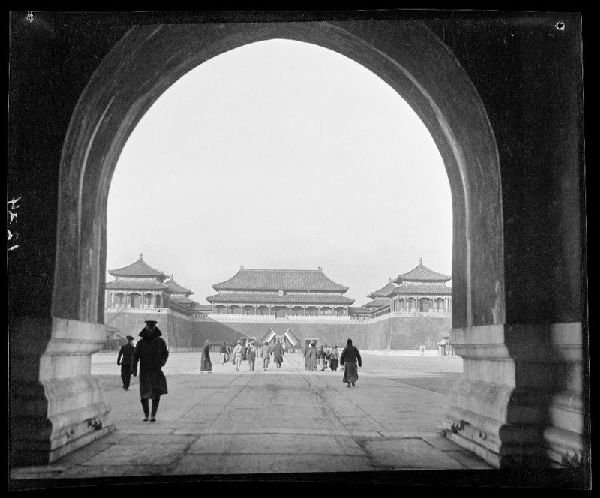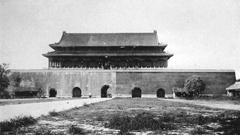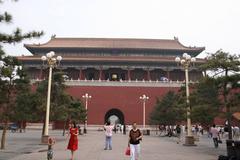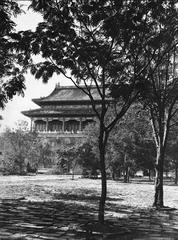Duanmen Beijing Visiting Hours, Tickets, and Historical Sites Guide
Date: 15/06/2025
Introduction to Duanmen Beijing
Duanmen (端门), also known as the Gate of Uprightness, stands as a majestic gateway along Beijing’s historic Central Axis, bridging the ceremonial expanse of Tian’anmen Square and the imperial grandeur of the Forbidden City. As an essential architectural and cultural landmark, Duanmen embodies centuries of China’s imperial history, reflecting Confucian ideals of hierarchy, harmony, and cosmic order. Its placement and design are testaments to meticulous urban planning, originating in the Ming Dynasty and refined during the Qing era. Today, Duanmen serves as both a preserved heritage site and a key feature of the UNESCO-recognized Central Axis of Beijing.
This comprehensive guide provides detailed insights into Duanmen’s historical context, architectural features, ceremonial functions, and practical visitor information. Whether you are a history enthusiast, architecture lover, or traveler seeking to delve into the heart of Beijing’s imperial heritage, this resource will help you plan a rewarding and informed visit.
For authoritative details and further reading, consult sources such as the Palace Museum, Beijing Central Axis UNESCO World Heritage Site, and China Discovery.
Contents
- Introduction to Duanmen Beijing
- Historical Background
- Origins and Urban Planning Context
- Architectural and Ceremonial Function
- Evolution Through Dynastic Changes
- Spatial and Symbolic Significance
- Preservation and Modern Adaptation
- Key Historical Milestones
- Duanmen in the Context of the Forbidden City
- Archaeological and Restoration Insights
- Visiting Duanmen: Practical Information
- Visiting Hours and Days
- Ticket Prices and How to Purchase
- Accessibility
- Travel Tips
- Nearby Attractions
- Special Events and Guided Tours
- Photographic Spots
- Frequently Asked Questions (FAQ)
- Conclusion
- Sources and Further Reading
Historical Background
Origins and Urban Planning Context
Duanmen is a critical component of Beijing’s Central Axis, a spatial and symbolic backbone that has defined the city’s urban fabric since the Yuan Dynasty (1271–1368). The axis, running 7.8 kilometers from the Bell and Drum Towers in the north to Yongdingmen in the south, was established as a manifestation of ancient Chinese cosmological and political principles, emphasizing symmetry, hierarchy, and harmony (sjohss.org). The Ming Dynasty retained and enhanced this axis, moving the city center slightly south and constructing formidable city walls, while the Qing Dynasty continued to maintain and honor the axis through restoration and adaptation.
Duanmen’s deliberate placement between Tian’anmen and the Meridian Gate (Wumen) was central to the ceremonial sequence leading to the heart of imperial power. Its role as a transitional gateway symbolized the passage from public civic space to the sacred precincts of the emperor.
Architectural and Ceremonial Function
Duanmen was historically much more than a physical barrier; it served as a ceremonial threshold. It stored ceremonial items and played a pivotal role in imperial processions, orchestrating the progression of individuals from the public to the most private and sacred spaces of the Forbidden City (english.beijing.gov.cn). The gate’s design follows strict principles of symmetry and hierarchy, with a grand gatehouse atop a high stone platform, red-painted walls, upturned eaves, and a multi-eaved, yellow-glazed tiled roof—each element laden with symbolic meaning.
The central passageway was reserved for the emperor, while side passages accommodated officials and guards, reinforcing the court’s rigid hierarchy (gearthhacks.com). Decorative features such as dougong brackets, painted beams, and carved balustrades highlight exquisite Ming craftsmanship.
Evolution Through Dynastic Changes
Duanmen has witnessed and adapted to the political and architectural shifts of successive dynasties. The Yuan Dynasty established the foundational layout, the Ming Dynasty expanded and refined the gate within the Forbidden City’s grand design, and the Qing Dynasty preserved and restored it, ensuring continuity of imperial tradition (sjohss.org). In the modern era, Duanmen has been integrated into heritage preservation efforts, now housing the Duanmen Digital Museum as part of the Palace Museum complex (english.beijing.gov.cn).
Spatial and Symbolic Significance
Duanmen’s location is crucial to the spatial logic of the Forbidden City, guiding visitors through a ceremonial progression from Tian’anmen Square to the inner sanctum of the imperial palace. This sequence exemplifies the Confucian order, with each gate marking a deeper level of exclusivity and authority (thebeijingcenter.org). The gate’s role in state rituals—such as imperial enthronements and edict announcements—underscores its importance as a symbol of legitimacy and power.
Preservation and Modern Adaptation
Recent decades have seen significant restoration and adaptation of Duanmen to ensure its preservation for future generations. Restoration projects follow UNESCO guidelines, using traditional materials and techniques to maintain historical integrity while enhancing accessibility (chinaculturetour.com). The Duanmen Digital Museum offers interactive exhibits and educational resources that deepen public engagement and understanding.
Key Historical Milestones
- Yuan Dynasty (1271–1368): Establishment of the Central Axis and Dadu’s urban layout.
- Ming Dynasty (1368–1644): Construction of the Forbidden City, with Duanmen as a key gateway.
- Qing Dynasty (1644–1912): Restoration and maintenance of Duanmen within the imperial precinct.
- Modern Era: Integration into the Palace Museum and the UNESCO World Heritage initiative.
Duanmen in the Context of the Forbidden City
Visitors entering from Tian’anmen Square first pass through Tian’anmen Gate, then Duanmen, before reaching the Meridian Gate—the main entrance to the Forbidden City. This orchestrated sequence impresses upon visitors the grandeur and authority of the imperial court and mirrors the journey from the public to the sacred (english.beijing.gov.cn).
Archaeological and Restoration Insights
Archaeological work and restoration have revealed original foundations, construction methods, and decorative details, illuminating the craftsmanship of the Ming and Qing periods. Preservation efforts focus on maintaining architectural authenticity and public accessibility (english.beijing.gov.cn).
Visiting Duanmen: Practical Information
Visiting Hours and Days
- Opening Hours: 8:30 AM – 5:00 PM (April–October); 8:30 AM – 4:30 PM (November–March).
- Last Entry: 4:00 PM (April–October), 3:30 PM (November–March).
- Closed: Mondays (except public holidays or special occasions).
- Always check the official Palace Museum website for seasonal updates.
Ticket Prices and How to Purchase
- Tickets: Required for entry to the Forbidden City, which includes access via Duanmen.
- Pricing: 60 CNY (peak season), 40 CNY (off-peak), with discounts for children, students, and seniors.
- Purchase: Must be booked online in advance via the official Palace Museum ticketing website or authorized vendors. No on-site sales.
- Entry: Present your passport and ticket code at the entrance for verification.
Accessibility
- Wheelchair Access: Main entrances and designated routes are wheelchair accessible.
- Services: Free wheelchairs and strollers available at the southern and northern gates.
- Facilities: Accessible restrooms and visitor service centers near Duanmen.
Travel Tips
- Arrive early to avoid crowds, especially during weekends or public holidays.
- Bring your passport, comfortable walking shoes, water, sun protection, and a camera.
- Photography is permitted outdoors; flash and tripods are restricted inside museum areas.
- Large luggage is not allowed; free storage is available at the Visitor Service Center west of Duanmen Square.
Entry and Security
- Route: After security at Tiananmen Square, Duanmen is the first major gate en route to the Forbidden City.
- Security: Expect airport-style bag checks; large bags must be stored outside.
Guided Tours and Special Events
- Guided Tours: Available through the Palace Museum and reputable agencies, offering expert commentary on Duanmen and other Central Axis sites.
- Audio Guides: Multilingual audio guides and apps such as Audiala provide self-guided options.
- Special Events: Occasionally hosts exhibitions and interactive educational programs.
Nearby Attractions
- Tian’anmen Square: Modern and historical epicenter of Beijing, directly south of Duanmen.
- Forbidden City: Iconic palace complex, entered via the Meridian Gate after passing Duanmen.
- Jingshan Park: Offers panoramic views of the Forbidden City and Central Axis.
- Beihai Park and Wangfujing: Other notable attractions within walking distance.
Facilities and Visitor Services
- Restrooms: Available near Duanmen Square; mostly squat toilets—bring tissue.
- Luggage Storage: Free at the Visitor Service Center; collect items at the north exit (Shenwumen).
- First Aid: On-site assistance available; staff may have limited English.
Connectivity
- Signage: English and Chinese, but translations may be limited.
- Wi-Fi: Limited public Wi-Fi; consider a local SIM or portable hotspot.
- Apps: Download translation and navigation apps before arrival.
Photographic Spots
- Capture Duanmen’s symmetry and architectural details from the plaza.
- For panoramic shots, head to Jingshan Park for elevated views of Duanmen and the palace rooftops.
Frequently Asked Questions (FAQ)
Q: What are Duanmen’s visiting hours?
A: Duanmen follows the Forbidden City’s schedule: 8:30 AM – 5:00 PM (peak season), 8:30 AM – 4:30 PM (off-peak), with last entry 1 hour before closing.
Q: How do I purchase tickets for Duanmen?
A: Tickets for the Forbidden City, including Duanmen, must be booked online in advance. No separate Duanmen tickets exist.
Q: Is Duanmen accessible to wheelchair users?
A: Yes, main routes are accessible, and wheelchairs are available at the gates.
Q: Are guided tours available?
A: Yes, both official and third-party tours cover Duanmen as part of Forbidden City itineraries.
Q: Is photography allowed at Duanmen?
A: Outdoor photography is permitted; indoor restrictions may apply.
Q: Are luggage storage and visitor services available?
A: Yes, free luggage storage and visitor services are provided at the Visitor Service Center near Duanmen.
Conclusion
Duanmen stands as a monumental testament to Beijing’s imperial history, architectural sophistication, and the enduring cultural values that have shaped the city’s development for centuries. As a key feature of the Central Axis—now a UNESCO World Heritage Site—Duanmen not only illustrates the hierarchical and cosmological principles underpinning ancient Chinese urban planning but also serves as a living bridge between the city’s imperial past and its vibrant present.
With clear visiting hours, modern ticketing processes, and enhanced accessibility, Duanmen welcomes visitors of all backgrounds to explore, learn, and connect with the enduring legacy of Beijing’s Forbidden City. For the best experience, secure tickets in advance, plan your visit during off-peak times, and consider joining a guided tour. Continue your journey of discovery by exploring nearby attractions and utilizing resources such as the Audiala app for immersive audio tours.
For more information and updates, visit the official Palace Museum website and consult additional insights from The Beijing Center.
Sources and Further Reading
- Palace Museum: Landmarks along the Central Axis
- Beijing’s Historic Central Axis: A UNESCO World Heritage Site
- Duanmen, Wikipedia
- The Forbidden City’s Architecture, Symbolism, and Design
- Forbidden City: A Complete Guide – Trevallog
- Beijing Travel Guide – China Discovery
- China Culture Tour: Beijing Culture
- Forbidden City Visitor Guide – Ruqin Travel
- How to Visit the Forbidden City – Tour Beijing

















































